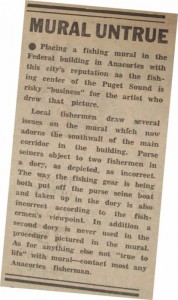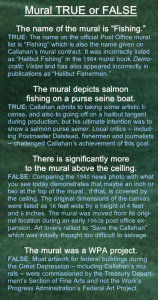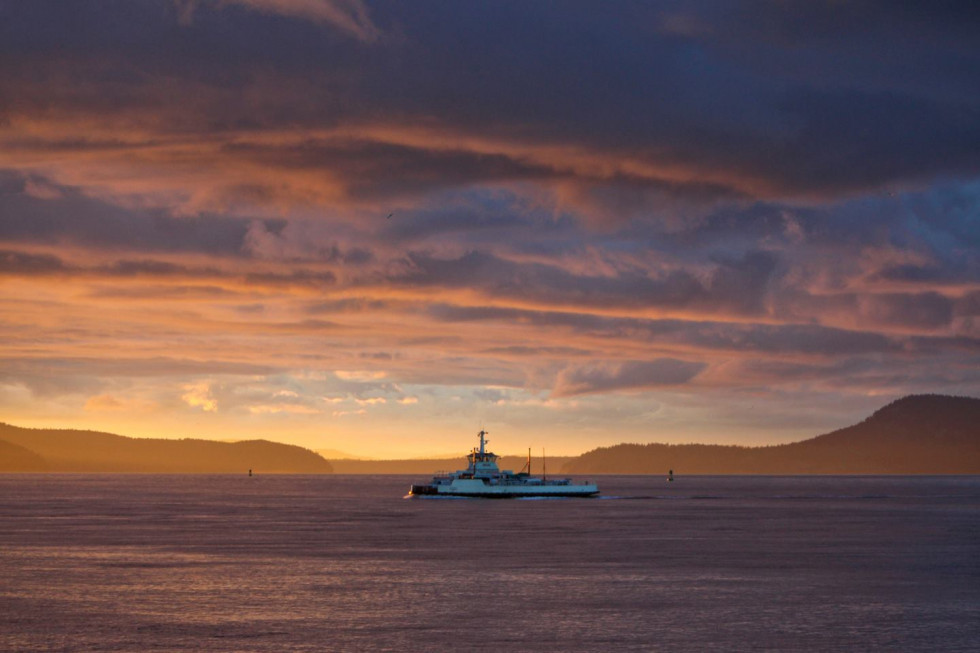
The contentious design of Kenneth Callahan’s
“Fishing” mural in the Anacortes Post Office
A lost art treasure by William Cumming was recently found in a Skagit County barn – a Great Depression mural depicting Skagit Valley agricultural history which was painted for Burlington High School’s Farm Shop in 1941. This discovery has renewed interest in the New Deal era murals of Skagit County – the 1938 “Local Pursuits” mural by Ambrose Patterson at the old Mount Vernon post office bears a thematic resemblance to the Cumming mural. The social-realist style is also present in the Albert Runquist mural of “Loggers and Millworkers” in Sedro-Woolley. Perhaps the most valuable of all of these is the “Fishing” mural painted for the Anacortes Post Office by Kenneth Callahan in 1940, a study of which is featured in the Anacortes Museum’s new exhibit ALL IN THE SAME BOAT: Anacortes in the Great Depression.
 For nearly 75 years a beautiful Great Depression-era mural painted by “Northwest Mystic” artist Kenneth Callahan has been enriching the lives of postal customers in Anacortes, Washington. And for over thirty years this masterpiece depicting crewmen on a salmon purse-seiner has been misidentified with the name “Halibut Fishermen.” What’s interesting about this error is how it hints at the artistic struggles concealed in the layers of paint on Callahan’s canvas, compelling us to wonder if there is more to it – above the ceiling figuratively and literally. You’ve heard that too – that only the bottom half of the mural is shown. Untrue, but why does this painting inspire such myths?
For nearly 75 years a beautiful Great Depression-era mural painted by “Northwest Mystic” artist Kenneth Callahan has been enriching the lives of postal customers in Anacortes, Washington. And for over thirty years this masterpiece depicting crewmen on a salmon purse-seiner has been misidentified with the name “Halibut Fishermen.” What’s interesting about this error is how it hints at the artistic struggles concealed in the layers of paint on Callahan’s canvas, compelling us to wonder if there is more to it – above the ceiling figuratively and literally. You’ve heard that too – that only the bottom half of the mural is shown. Untrue, but why does this painting inspire such myths?
To verify “Fishing” as the only official title of this painting required the help of the National Archives, which provided over sixty pages of heated correspondence between Callahan and Postmaster Gus Dalstead. Their triangulated arguments are at the heart of the naming confusion, which has persisted to this day. Upon installation in 1940, the all-caps headline in the Anacortes American shouted MURAL UNTRUE. This art and fish story contains more than you probably want to know about a famous artist’s “mural decoration” inside the Anacortes Post Office.
Kenneth Callahan was born in Spokane in 1905 and was working as a part time curator at the Seattle Art Museum in 1939 when he was invited to submit designs to the Treasury Department’s Section of Fine Arts (not the Works Progress Administration (WPA) as is often assumed) for a “mural decoration” at the Anacortes Post Office. The artist was advised to “confer with the postmaster relative to suitable subject matter relating to the locals.” In a prescient May 3, 1939 letter, Assistant Chief of the Fine Arts Section, Edward Rowan, urged such an artist/postmaster conference: “In our experience, we have found that this often saves a good deal of misunderstanding and heartache.”
Callahan would go on to international artistic renown grouped in the “Northwest School” with Morris Graves, Guy Anderson and Mark Tobey and famously dubbed one of the “Mystic painters of the Northwest” in a Life magazine article published in September of 1953. The mural invitation was offered on the basis of work submitted for the Wenatchee Post Office competition. In 1939, Callahan was not unfamiliar with painting waterfront themes. His “Fishermen, Lake Union, 1929” and “Men Who Work the Ships,” an 11-panel mural done in 1933, are classic examples of the Social Realism paintings made during the Great Depression. He had already completed “Industries of Lewis County,” depicting cow-milking, strawberry picking and more for the Centralia, Washington Post Office and another mural “Rugby – the Geographical Center of North America” in North Dakota.
 From the perspective of Gustaf Dalstead, Anacortes Postmaster and civic leader for decades to come, the issue was getting it right for Anacortes. Dalstead – a butcher who became postmaster in 1936 – was undoubtedly proud of the new brick building on the site formerly occupied by the Vendome Hotel, demolished in 1937. The post office had bounced around various town structures since the first Anacortes Post Office was established at Bowman’s Store in 1879. Dalstead was protective of the image of the post office and wanted an authentic design for the interior mural; he knew that getting it wrong would be an embarrassment. His customers would take it out on him, not Callahan or Ronan or east coast art critic Forbes Watson, who approved of the design having “originality and real quality of weight.” Initially, Callahan remained overtly deferential to Dalstead’s local knowledge, stating:
From the perspective of Gustaf Dalstead, Anacortes Postmaster and civic leader for decades to come, the issue was getting it right for Anacortes. Dalstead – a butcher who became postmaster in 1936 – was undoubtedly proud of the new brick building on the site formerly occupied by the Vendome Hotel, demolished in 1937. The post office had bounced around various town structures since the first Anacortes Post Office was established at Bowman’s Store in 1879. Dalstead was protective of the image of the post office and wanted an authentic design for the interior mural; he knew that getting it wrong would be an embarrassment. His customers would take it out on him, not Callahan or Ronan or east coast art critic Forbes Watson, who approved of the design having “originality and real quality of weight.” Initially, Callahan remained overtly deferential to Dalstead’s local knowledge, stating:
Following your suggestion regarding the fishing industry, I investigated further, and believe that the salmon and purse seining would be a very appropriate subject. I need not go into the details of this, as it is an industry with which you are familiar, fully appreciating the color and interest it offers to a mural decoration.
Dalstead responded: “I have in mind a number of very scenic pictures including purse-seine boats and cannery tenders in groups and various water front activities. These I think, would be of great interest to you.” Sometime between spring and fall of 1939, and likely due to their agonized communications, Callahan got off track on the “Fishing” mural’s central theme: “The only changes I have made from the small sketch is in authenticating the costumes on figures and details of boat and gear to make it right as a halibut boat fishing.” Callahan seemed to have forgotten (in September) how he had described the mural subject (in May), as “purse-seining and salmon recognized as Anacortes’ raison d’etre,” as Callahan put it, somewhat condescendingly.
By October 19, 1939, Callahan was back on track after a visit with Dalstead in which the artist acknowledged his error: “He is willing to accept the fishing idea, but prefers it should be purse seining for salmon rather than halibut fishing. This should not involve major changes, mostly in gear, etc., as the boats in general construction are the same, and the operations are not dissimilar. He is right in wishing the change, as salmon is much more important to the town itself as there are salmon canneries located there.”
However, Dalstead’s dissatisfaction with the design continued, and an April telegram (all caps and no punctuation) conveyed the Postmaster’s criticisms:
THE SMALL BOAT IS ALL OUT OF PROPORTION THE SECOND SMALL BOAT IS NEVER USED AT LEAST AROUND HERE THE PEOPLE HERE DO THIS FISHING FOR A LIVING IT IS IMPORTANT FOR THEM AND THEY WILL LAUGH AT THIS PICTURE I WOULD SUGGEST THAT YOU TAKE THIS PICTURE DOWN TO THE WATER FRONT AND TALK TO SOME OF THE FISHERMEN I AM SORRY TO CAUSE YOU EXTRA TROUBLE OR WORK ON THIS BUT I COULD NOT PERMIT YOU TO INSTALL IT AS IS WITHOUT YOUR GUARANTEE THAT IF IT CAUSES TOO MUCH CRITICISM THAT YOU WOULD TAKE IT DOWN AND RE DO IT
Nonetheless, the mural was installed on Sunday, May 12, 1940. Callahan heard comments from fishermen: “It sure looks natural, you’ve got everything but the wind – out there it blows 450 miles an hour.” Callahan went on:
“One other fisherman, alone, said, ‘It doesn’t look right to me, we don’t work like that.’ I told him a salmon fisherman had said it was right to him. He replied, ‘That guy told you wrong, don’t get sore, I think you have a damned good job there, but it ain’t quite right.’ So there are two sides to the story and I don’t know what to think.”
You might ask why this painting is presently referred to as “Halibut Fishermen” in local art pamphlets and academic websites when it depicts fishermen on a salmon purse seine boat and was officially titled “Fishing.” While the mix-up was part of the original design and re-design, news accounts never called the painting by name, even during the 1960s effort to “Save the Callahan” during a post office remodel. Not until the mid-1980s did the mural come to be referred to by name, and erroneously as halibut fishing. Speculation centers on the 1984 publication of the book DemocraticVistas: Post Offices and Public Art in the New Deal, which is about the time that references to halibut began coming up. People have been less curious about the name than the tantalizing idea that there is more to it – wondering if more of the canvas exists above the ceiling tiles. However, original measurements of the mural height and photographs from the time of installation suggest that virtually all of the mural is still in view.
Yet there is more to it – measurable not in square feet of canvas but in symbolic meaning. In a much later interview, Callahan stated: “Painting, for my point of view, is realizing symbols that are presently created by yourself that will have meanings for other people. That’s the whole thing that is in back of painting: creation of symbols.” Postmaster Dalstead would probably agree, but still angle for control of the symbols displayed in the Anacortes Post Office; he had claimed that “the community is very much opposed to some of the types of murals installed in this county.” In this sense the painting not only depicts a historic fishing scene, but also the ongoing struggle between individual creative expression and conflicting interpretations of authenticity in public art. There truly is more to it than meets the eye.
(An excerpt from a much longer – if you can believe it – article by Bret Lunsford)
